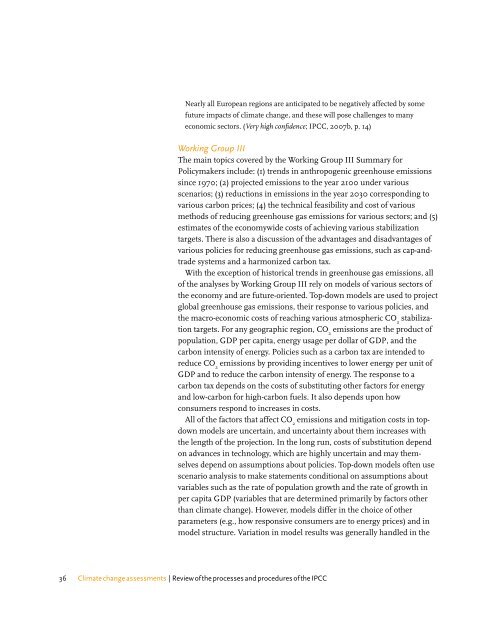Climate change assessments Review of the processes and ...
Climate change assessments Review of the processes and ...
Climate change assessments Review of the processes and ...
Create successful ePaper yourself
Turn your PDF publications into a flip-book with our unique Google optimized e-Paper software.
Nearly all European regions are anticipated to be negatively affected by some<br />
future impacts <strong>of</strong> climate <strong>change</strong>, <strong>and</strong> <strong>the</strong>se will pose challenges to many<br />
economic sectors. (Very high confidence; IPCC, 2007b, p. 14)<br />
Working Group III<br />
The main topics covered by <strong>the</strong> Working Group III Summary for<br />
Policymakers include: (1) trends in anthropogenic greenhouse emissions<br />
since 1970; (2) projected emissions to <strong>the</strong> year 2100 under various<br />
scenarios; (3) reductions in emissions in <strong>the</strong> year 2030 corresponding to<br />
various carbon prices; (4) <strong>the</strong> technical feasibility <strong>and</strong> cost <strong>of</strong> various<br />
methods <strong>of</strong> reducing greenhouse gas emissions for various sectors; <strong>and</strong> (5)<br />
estimates <strong>of</strong> <strong>the</strong> economywide costs <strong>of</strong> achieving various stabilization<br />
targets. There is also a discussion <strong>of</strong> <strong>the</strong> advantages <strong>and</strong> disadvantages <strong>of</strong><br />
various policies for reducing greenhouse gas emissions, such as cap-<strong>and</strong>trade<br />
systems <strong>and</strong> a harmonized carbon tax.<br />
With <strong>the</strong> exception <strong>of</strong> historical trends in greenhouse gas emissions, all<br />
<strong>of</strong> <strong>the</strong> analyses by Working Group III rely on models <strong>of</strong> various sectors <strong>of</strong><br />
<strong>the</strong> economy <strong>and</strong> are future-oriented. Top-down models are used to project<br />
global greenhouse gas emissions, <strong>the</strong>ir response to various policies, <strong>and</strong><br />
<strong>the</strong> macro-economic costs <strong>of</strong> reaching various atmospheric CO 2<br />
stabilization<br />
targets. For any geographic region, CO 2<br />
emissions are <strong>the</strong> product <strong>of</strong><br />
population, GDP per capita, energy usage per dollar <strong>of</strong> GDP, <strong>and</strong> <strong>the</strong><br />
carbon intensity <strong>of</strong> energy. Policies such as a carbon tax are intended to<br />
reduce CO 2<br />
emissions by providing incentives to lower energy per unit <strong>of</strong><br />
GDP <strong>and</strong> to reduce <strong>the</strong> carbon intensity <strong>of</strong> energy. The response to a<br />
carbon tax depends on <strong>the</strong> costs <strong>of</strong> substituting o<strong>the</strong>r factors for energy<br />
<strong>and</strong> low-carbon for high-carbon fuels. It also depends upon how<br />
consumers respond to increases in costs.<br />
All <strong>of</strong> <strong>the</strong> factors that affect CO 2<br />
emissions <strong>and</strong> mitigation costs in topdown<br />
models are uncertain, <strong>and</strong> uncertainty about <strong>the</strong>m increases with<br />
<strong>the</strong> length <strong>of</strong> <strong>the</strong> projection. In <strong>the</strong> long run, costs <strong>of</strong> substitution depend<br />
on advances in technology, which are highly uncertain <strong>and</strong> may <strong>the</strong>mselves<br />
depend on assumptions about policies. Top-down models <strong>of</strong>ten use<br />
scenario analysis to make statements conditional on assumptions about<br />
variables such as <strong>the</strong> rate <strong>of</strong> population growth <strong>and</strong> <strong>the</strong> rate <strong>of</strong> growth in<br />
per capita GDP (variables that are determined primarily by factors o<strong>the</strong>r<br />
than climate <strong>change</strong>). However, models differ in <strong>the</strong> choice <strong>of</strong> o<strong>the</strong>r<br />
parameters (e.g., how responsive consumers are to energy prices) <strong>and</strong> in<br />
model structure. Variation in model results was generally h<strong>and</strong>led in <strong>the</strong><br />
36 <strong>Climate</strong> <strong>change</strong> <strong>assessments</strong> | <strong>Review</strong> <strong>of</strong> <strong>the</strong> <strong>processes</strong> <strong>and</strong> procedures <strong>of</strong> <strong>the</strong> IPCC

















